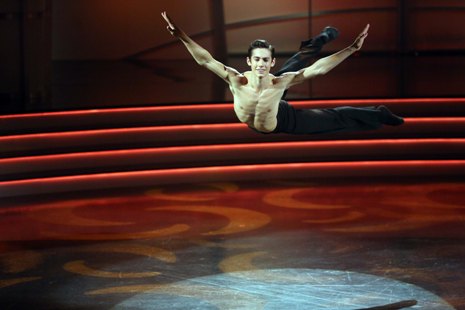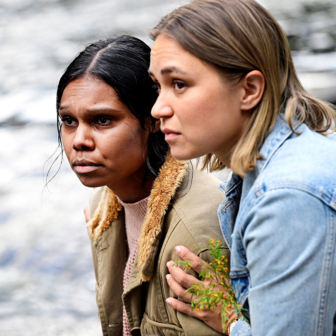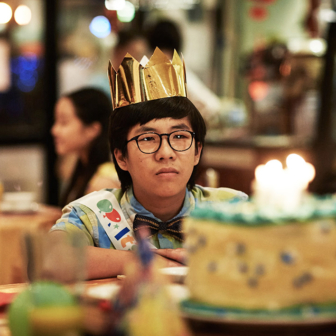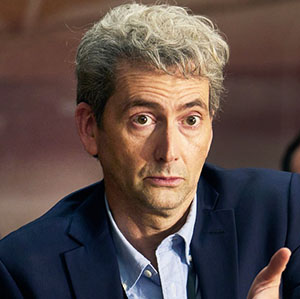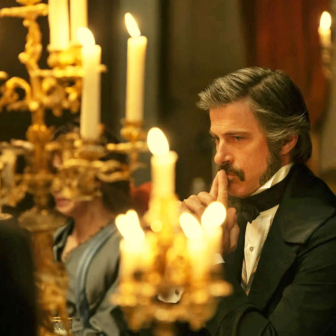THURSDAY’s finale of So You think You Can Dance (Network Ten) promised to be a fraught affair. Sam Malseed (pictured), a farmboy turned jazz-ballet dynamo, had been voted off the week before, leaving the talent pool somewhat thin at the top. Of the four contestants still running, only one had any real charisma or technical prowess.
For another, the judges had worked themselves into a state of semi-hysteria through the course of the season, as ratings fell over a cliff towards the quarter million mark. Week after week, Paula Abdul, Jason Gilkison and Aaron Cash gasped, cried real tears, and stood up in their seats to issue pronouncements. ‘Mag – Nificent!’ ‘You’re ripping our hearts out.’ ‘That was dancelicious!’ All this smacked of desperation, and desperation doesn’t sell.
It seems very unlikely there will be another season of SYTYCD in Australia, so now it was all over bar another round of shouting on Thursday night, and nothing short of a visit from Roy and HG could save it. How had things come to this pass?
TV talent shows are not generally an acquired taste: you love them or hate them, and it’s easier to lose the love than conquer the hate. They’re noisy, brash affairs, pumped up with overplayed emotion and a greed for climaxes that is unseemly to those for whom watching television is a form of idle relaxation. But some talent shows, like the contestants they feature, are better than others, and since I started following the US version in 2007, So You Think You Can Dance has impressed me as an especially good one.
When I first hit upon it back then, seeking a break from relentless Australian election coverage, it was immediately evident that someone was exercising a quality control from which its companions in the Simon Cowell stable – the Idol franchises, The X Factor, Britain’s Got Talent – seemed to have escaped. SYTYCD (as Google knows it) originated as the joint initiative of Cowell and Nigel Lythgoe, a former dancer and choreographer, and one of the most powerful entrepreneurs in what might be called “performance television.”
For all the on-camera hoo-ha of the audition process, it is Lythgoe’s selection of behind-the-scenes talent that really makes the show. Some of the best popular dance choreographers are on his team, and they create short feature performances designed to sort out the strengths and weaknesses of the dancers. The routines are staged with some flair: camera work, lighting design and costumes are of Broadway standard. The American program received eleven Emmy awards and thirty-seven nominations. Part of Lythgoe’s agenda is also to bridge the divide between entertainment and artistry in the dance world by involving dancers and choreographers from major companies as guest artists.
The Australian series was launched on Network 10 in 2008 and started out well, with ratings peaking at around two million. Some good decisions were made on the production side, including the choice of Carriageworks in Sydney as the setting. With its high panelled windows and massive industrial fittings, the cavernous building encouraged adventurous approaches to staging and choreography, and live audiences coincided with those who came to see the more avant-garde offerings in the Performance Space repertoire. I was involved in one of these myself in 2009, and it was curious to watch the two sides of a cultural equation lining up in the foyer. For the most part it was a standoff. The more accustomed artistic residents were cynical about the commercial imposters, and the lines of teenagers holding fan banners seemed oblivious to anything else going on in the environment.
But there were significant breaches in the divide. During the opening weeks of SYTYCD, Sydney Dance Company recorded more than 100,000 hits on its website. This may have helped persuade Rafael Bonachela to accept an invitation as a guest choreographer.
For the first three seasons of the Australian program, the chair of the judging panel was Jason Coleman, a seasoned choreographer and producer who could steer a middle course between party spirit and the need for some stern appraisal. The other two judges, dancer-choreographer Matt Lee, who looked about fifteen years old under his signature trilby hat, and Bonnie Lythgoe, were somewhat bland, but they kept the mood buoyant without overdoing it. Ratings bounced along comfortably, averaging some 1.5 million in the first season and remaining over a million through the second, in 2009. There was a significant dip in 2010, as there was for the American version, but the figures remained close to a million throughout. That wasn’t good enough for Ten, and a peremptory announcement of its termination was made before the final weeks of the program went to air.
In the United States, meanwhile, Lythgoe rode out the lean period in the ratings, which rose again in 2011 as SYTYCD continued to clock up the Emmies. This prompted a rethink in Australia, and the program was revived for a fourth series this year. Evidently, there was still much apprehension about audience appeal, and a new judging panel was appointed. Paula Abdul was brought in to give some star power; accompanying her were Jason Gilkison, the best of the choreographers from the earlier seasons of the Australian show, and Aaron Cash.
Their credentials are impressive. Gilkison is a former ballroom dancing champion, and has choreographed and directed major stage productions including the international touring extravaganza Burn the Floor. Cash was an original member of the Tap Dogs and has the distinction of being selected as a dance partner by both Cher and Twyla Tharp; more recently, he has been working as a choreographer with the Cuban company Ballet Revolucion. But they have too obviously been brought together as Team Desperate and their combined efforts are a recipe for disaster. “You’ve got to have the calmness of someone defusing a bomb in this dance,” Gilkison advises two hapless contestants after a painfully mediocre ballroom routine, but the judging panel themselves go off like Catherine wheels with wearying frequency.
Carping aside, though, this is a sad state of affairs. Public entertainment matters. From a historical perspective, dance may be its most enduring and widespread form, and dancers are prominent in the pantheon of theatrical superstars. Michael Jackson could sing, but it was as a dancer that he really set the audience on fire. The same is true of Madonna and Kylie. Pulp Fiction is packed with memorable scenes, but it is John Travolta who steals the movie, twisting with Uma Thurman.
And the talent show, for all its obvious offences to more sophisticated tastes, has a fundamental appeal to the popular imagination. Think how many dance films are about auditions or competitions in which an outsider breaks into the heavily protected magic circle of trained performers. The list would include the 1933 Busby Berkeley movie 42nd Street, Saturday Night Fever, Dirty Dancing, Strictly Ballroom, Step Up and Billy Elliot. The dramatic tension depends on the fate of the one who has somehow been kept off stage, but who steps from the wings to bring the house down. When the shouting is over, a star must be born.
Well, that could still happen. In the round of solos at the end of last week’s program, eighteen-year-old Michael Dameski performed a self-choreographed dance of quite astonishing virtuosity, demonstrating that precision, musicality and stage authority are inextricably related. Dameski is a veteran of talent shows, making the top ten of Australian Dance Idol at the age of six, and going on to win titles at the World Performing Arts Championships in Los Angeles and the National Dance Championships. He’s also spent four years performing in (and as) Billy Elliot, including a stint on Broadway. None of this precludes him from being a contestant on SYCYDC. His outsider credentials may be a little shaky, but if he rises to the occasion, he could still play out the time-honoured fantasy that Billy Elliot is all about.
As it has turned out, new media also had game-changing role to play in all this. During the days following the 24 April semi-final, the video clip of Dameski’s solo went viral. Lythgoe picked it up and tweeted that it was the best he’d seen, entrepreneurs and major dance companies got wind of it, and the fan based multiplied by hour. By the time the finals were ready to go to air, the results were done and dusted. The television audience was barely half that for the YouTube video of Dameski, which in turn was probably less than half the overall viewing rate for the clip.
But that’s the thing about talent shows: when they really deliver, the result is a performance that is the only thing you remember. Gifted male dancers are in demand around the world, and chances are we’ve just seen the launch of an international career. •
